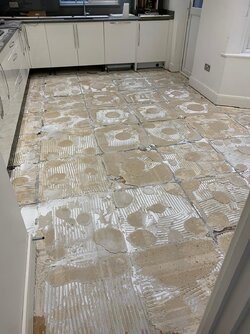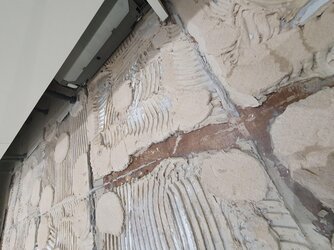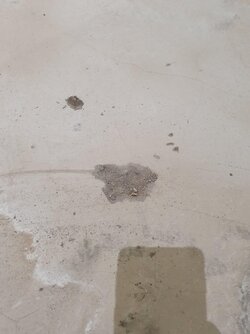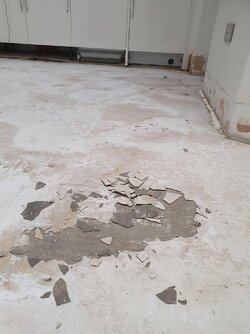Hi,
I recently purchased my first property and the existing kitchen floor porcelain tiles were all moving, some were cracked and the grout was missing in places and crumbling away.
I decided to get the whole floor re-done.
I found a tiler on RatedPeople to take it all up. He took up all the tiles and noticed that the previous installer put adhesive all over the plywood subfloor, leaving gaps in some places mind you, and then dot and dabbed the tiles with more adhesive onto the spread out adhesive. It looks like this was done in order to level the floor. In some places the adhesive was 2cm thick towards the back of the kitchen by the appliances but there was barely any adhesive towards the hallway end where the floor is higher. The tiles literally came off clean, most without breaking.
My tiler claimed that the lack of an uncoupling membrane and the very bad dot and dab technique is what caused the previous tiles to fail.
Pictures of what was unearthed are attached.
My new tiler removed the tiles and adhesive and said the floor was solid and that it just needed levelling prior to installing UFH with Ditra before tiling. He laid Ultra Tile Fix Pro Level One Deep Fill Floor Leveller to level the floor. Once laid, he put the central heating on at 25 degrees and left for it to dry.
The latex has since cracked all over the kitchen floor. Walking on it 5 days later is like walking on cracking ice. My entire house is humid and the latex on the shallower end of my kitchen comes up with little effort. It doesn't peel off towards the deeper end of the kitchen but it is still cracked everywhere. Pictures attached.
My new tiler has since said he does not want to complete the work and has left without taking any payment and I am now stuck with a kitchen that looks like a building site, covered in floor leveller that is cracked.
I am finding it hard to find a tiler to come and rectify this problem. What exactly needs to be done? I am lost. There are so many different opinions. All I want is the floor to be fixed with UFH in place.
Some tilers are saying the plywood should come up, that I should install cement board, without an uncoupling membrane and then tile. Some are saying to use insulation boards with no need for a membrane. Others are saying so install the UFH first and then use latex leveller on top.
I'm really lost. What can I do? Can someone please explain to me exactly what needs to be done? assuming:
1. I leave the plywood
2. I replace the plywood with something else.
Do I need an uncoupling membrane? Do I need cement board? Do I need insulation boards? What order should all this be done?
Please bear in mind, I don't have much height to play with. My kitchen it shallower at the hallway end (picture attached showing where it meets the wooden flooring of my hallway) and deeper at the appliance end. I don't want to run the risk of not being able to take the appliances out. I have attached as many pictures as I can.
Really hoping to get some good advice from the experts here.
Thanks
I recently purchased my first property and the existing kitchen floor porcelain tiles were all moving, some were cracked and the grout was missing in places and crumbling away.
I decided to get the whole floor re-done.
I found a tiler on RatedPeople to take it all up. He took up all the tiles and noticed that the previous installer put adhesive all over the plywood subfloor, leaving gaps in some places mind you, and then dot and dabbed the tiles with more adhesive onto the spread out adhesive. It looks like this was done in order to level the floor. In some places the adhesive was 2cm thick towards the back of the kitchen by the appliances but there was barely any adhesive towards the hallway end where the floor is higher. The tiles literally came off clean, most without breaking.
My tiler claimed that the lack of an uncoupling membrane and the very bad dot and dab technique is what caused the previous tiles to fail.
Pictures of what was unearthed are attached.
My new tiler removed the tiles and adhesive and said the floor was solid and that it just needed levelling prior to installing UFH with Ditra before tiling. He laid Ultra Tile Fix Pro Level One Deep Fill Floor Leveller to level the floor. Once laid, he put the central heating on at 25 degrees and left for it to dry.
The latex has since cracked all over the kitchen floor. Walking on it 5 days later is like walking on cracking ice. My entire house is humid and the latex on the shallower end of my kitchen comes up with little effort. It doesn't peel off towards the deeper end of the kitchen but it is still cracked everywhere. Pictures attached.
My new tiler has since said he does not want to complete the work and has left without taking any payment and I am now stuck with a kitchen that looks like a building site, covered in floor leveller that is cracked.
I am finding it hard to find a tiler to come and rectify this problem. What exactly needs to be done? I am lost. There are so many different opinions. All I want is the floor to be fixed with UFH in place.
Some tilers are saying the plywood should come up, that I should install cement board, without an uncoupling membrane and then tile. Some are saying to use insulation boards with no need for a membrane. Others are saying so install the UFH first and then use latex leveller on top.
I'm really lost. What can I do? Can someone please explain to me exactly what needs to be done? assuming:
1. I leave the plywood
2. I replace the plywood with something else.
Do I need an uncoupling membrane? Do I need cement board? Do I need insulation boards? What order should all this be done?
Please bear in mind, I don't have much height to play with. My kitchen it shallower at the hallway end (picture attached showing where it meets the wooden flooring of my hallway) and deeper at the appliance end. I don't want to run the risk of not being able to take the appliances out. I have attached as many pictures as I can.
Really hoping to get some good advice from the experts here.
Thanks
Attachments
-
 IMG-20210121-WA0001.jpg276.9 KB · Views: 141
IMG-20210121-WA0001.jpg276.9 KB · Views: 141 -
 20210121_223006.jpg525.5 KB · Views: 122
20210121_223006.jpg525.5 KB · Views: 122 -
 20210126_200220.jpg216.4 KB · Views: 106
20210126_200220.jpg216.4 KB · Views: 106 -
 20210126_200631.jpg337.9 KB · Views: 110
20210126_200631.jpg337.9 KB · Views: 110 -
 20210125_193333.jpg309.7 KB · Views: 108
20210125_193333.jpg309.7 KB · Views: 108 -
 20210122_093205(1).jpg877.7 KB · Views: 121
20210122_093205(1).jpg877.7 KB · Views: 121 -
 20210123_220858.jpg392.4 KB · Views: 126
20210123_220858.jpg392.4 KB · Views: 126 -
 20210121_222239.jpg721.2 KB · Views: 132
20210121_222239.jpg721.2 KB · Views: 132 -
 20210121_222843(1).jpg452 KB · Views: 145
20210121_222843(1).jpg452 KB · Views: 145 -
 20210123_220820.jpg558.7 KB · Views: 137
20210123_220820.jpg558.7 KB · Views: 137

